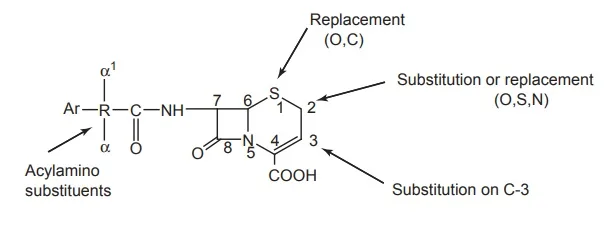Cephalosporins are a family of antibiotics known as beta-lactams. They have a broad spectrum of action against both gram-positive and gram-negative bacteria and are both structurally and functionally similar to penicillin.
Cephalosporins are semisynthetic β-lactam derivatives which have broad-spectrum bactericidal activity.
Cephalosporins usually have a designation as belonging to a generation, first through fifth, to indicate a broad range of activity. Cephalosporins antimicrobials of the five generations are effective against skin infections, resistant bacteria, meningitis, and other diseases.
Structure of Cephalosporins
Cephalosporins are antibiotics that share the structure of a beta-lactam ring linked to a dihydrothiazine ring. The antibacterial action is attributed to the beta-lactam ring, while the dihydrothiazine ring offers molecular stability.
Cephalosporins’ structures may be altered by adding different chemical groups to the molecule, resulting in distinct generations of them with variable activity spectrum and pharmacokinetic features. First-generation cephalosporins, for example, include a methyl group connected to the dihydrothiazine ring, but subsequent generations have additional chemical groups that boost their efficacy against gram-negative bacteria and resistance to bacterial enzymes that can break down the medicine.

The chemical changes to the cephalosporin molecule impact its method of administration as well as their bioavailability. Some can be taken orally, while others must be administered intravenously or intramuscularly. Furthermore, the half-life and clearance of cephalosporins vary between generations, which may impact frequency of administration and treatment duration.
Classification of Cephalosporins
Cephalosporins are generally classified based on their spectrum of activity and their resistance to bacterial enzymes that can break down the drug.

First-generation cephalosporins are effective towards most gram-positive cocci such as staphylococci spp. and streptococci spp., in addition to some gram-negative bacteria, such as Escherichia coli (E. coli), Proteus mirabilis, and Klebsiella pneumoniae. It includes Cefazolin, cephalothin, cephapirin, cephradine, cefadroxil, and cephalexin.
Second-generation cephalosporins are effective against Haemophilus influenzae (H. influenzae), Moraxella catarrhalis, and Bacteroides spp. They are classified into two groups: second-generation and cephamycin subgroups. Cefuroxime and cefprozil are two second-generation subtypes. Cefmetazole, cefotetan, and cefoxitin are all members of the cephamycin subgroup.
Third-generation cephalosporins provide dropped protection against most gram-positive pathogens but greater efficacy against Enterobacteriaceae, Neisseria spp., and H. influenzae. It includes include cefotaxime, ceftazidime, cefdinir, ceftriaxone, cefpodoxime, cefoperazone, and cefixime. Third-generation antibiotics, particularly ceftriaxone and cefotaxime, can cross the blood-brain barrier and cover microorganisms in the cerebral spinal fluid when administered intravenously.
Fourth-generation cephalosporins offer comparable coverage as third-generation cephalosporins, but with added coverage against gram-negative bacteria with antibiotic resistance, such as beta-lactamase. Fourth-generation cephalosporin includes cefepime. Although it is effective against both gram-positive and gram-negative bacteria, cefepime is only used to treat severe systemic infections in patients who are likely to have multi-resistance organisms.
Fifth-generation cephalosporins are effective against methicillin-resistant staphylococci and penicillin-resistant pneumococci. Ceftaroline is a fifth-generation cephalosporin. Ceftaroline is also a broad-spectrum antibiotic, thus it can kill both gram-positive and gram-negative bacteria. Listeria monocytogenes and Enterococcus faecalis can also be treated with ceftaroline. Ceftaroline, on the other hand, does not treat Pseudomonas aeruginosa.
Mechanism of Action
Cephalosporins are a kind of β-lactam antibiotic that are similar to penicillins. They are bactericidal through the same mechanism as other beta-lactams.
Bacteria develop a cell wall by cross-linking peptidoglycan units using penicillin-binding proteins (PBP, peptidoglycan transpeptidase). These are a wide class of bactericidal antimicrobials generated from the fungus Cephalosporium sp. These antibiotics bind to PBPs and prevent them from cross-linking the peptidoglycan strands, leading to the formation of a weakened cell wall that is unable to maintain its structural integrity. This results in the osmotic pressure causing the bacterial cell to swell and eventually rupture, leading to the death of the bacteria.

First-generation cephalosporins inhibit bacterial cell wall formation. They inhibit the production of the peptidoglycan layer that forms the bacterial cell wall. The peptidoglycan layer is essential for the structural integrity of the cell wall.
Second-generation cephalosporins include beta-lactam rings that attach to the penicillin-binding protein and stop peptidoglycan cross-linking. The cell wall is damaged as an outcome of this activity, culminating in lysis (cell wall rupture) and death of the bacterial cell.
Third-generation cephalosporins, structural binding of these antibiotics to the active site of PBPs in bacterial cell walls hinders its enzymatic activity which results in faulty peptidoglycan synthesis, leading to the failure to make a functional cell wall and subsequent bacterial cell death by osmotic lysis.
Fourth generation are zwitterionic compounds, which facilitates rapid penetration through the outer membrane of Gram-negative bacteria.
Fifth generation cephalosporins acts through inhibition of cell wall biosynthesis, and is mediated through binding to penicillin-binding proteins (PBPs).
Side effects
- Gastrointestinal disturbances: Cephalosporins can cause nausea, vomiting, diarrhea, and abdominal pain. These symptoms are usually mild and go away on their own, but they can sometimes be severe and require medical attention.
- Allergic reactions: Some people may develop an allergic reaction to cephalosporins, which can range from a mild rash to a severe allergic reaction called anaphylaxis. People who have a history of penicillin allergy are at a higher risk of developing an allergic reaction.
- Superinfection: They can disrupt the natural balance of bacteria in the body and lead to the growth of drug-resistant bacteria, causing a superinfection. Symptoms of a superinfection can include fever, diarrhea, and vaginal discharge.
- Kidney problems: They can sometimes cause kidney problems, such as acute interstitial nephritis, which can lead to kidney damage if left untreated. Symptoms of kidney problems include swelling in the legs and ankles, fatigue, and decreased urine output.